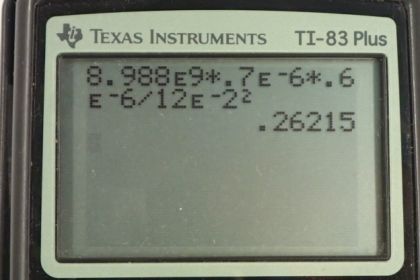Question
(a) How strong is the attractive force between a glass rod with a charge and a silk cloth with a charge, which are 12.0 cm apart, using the approximation that they act like point charges? (b) Discuss how the answer to this problem might be affected if the charges are distributed over some area and do not act like point charges.
Final Answer
- If charges are distributed, the resultant force between the objects would be the vector sum of each force on each charge due to the resultant electric field at each charge. Things would get complicated!
Solution video
OpenStax College Physics for AP® Courses, Chapter 18, Problem 25 (Problems & Exercises)

vote with a rating of
votes with an average rating of
.
Calculator Screenshots
Video Transcript
This is College Physics Answers with Shaun Dychko. We're going to calculate the size of the force between a glass rod of charge 0.7 micro Coulombs and a silk cloth of charge 0.6 micro Coulombs, negative. And the distance between them is 12 centimeters which is 12 times ten to the minus two meters. So the magnitude of the force is going to be k times q1q2 and these are magnitudes of these charges, divided by the distance between them squared. So that's Coulombs Constant times 0.7 times ten to the minus six Coulombs times 0.6 times ten to the minus six Coulombs divided by 12 times ten to the minus two meters squared, giving a force of 0.262 newtons. And this force is going to be attracted because they're of opposite charge but the question only asks us to find how strong the force is and so what is it's magnitude or absolute value in other words. Part b says, what if the charges are distributed over the objects; the glass rod and the silk cloth. Well, the resultant force then would be the vector sum of each force due to the resultant electric field, due to each other charge. And things would get quite complicated. So that's why it's nice that these are assumed to be point charges.
